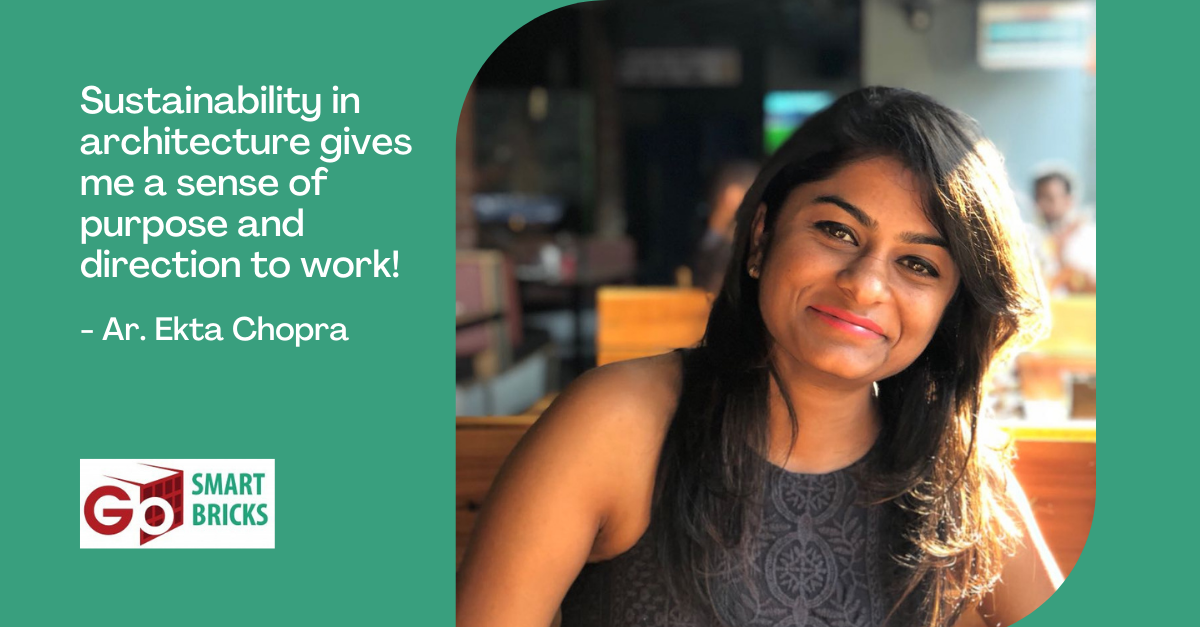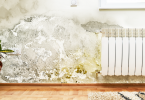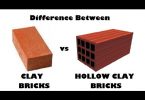GoSmartBricks spoke to Architect Ekta Chopra. She strongly believes that any built form that can be titled as sustainable architecture involves methods of conservation in the entire process. Right from during the course of construction to the provision of methods for preservation of natural resources and for the inhabitant to use them sustainably.
GSB: What originally made you want to study architecture and become an architect?
Ekta: I did not grow up wanting to be an Architect. I do not have any family background in Architecture whatsoever! Coming from a business family and most people in the family in my generation having studied engineering, Management or Commerce, that’s where I was directed too. But I was not the one to follow the herd. When the time came for me to choose my Profession, I started exploring and reading about various fields before deciding what to do.
I wanted to do something exciting and challenging, unique and impactful.
Architecture has the ability to touch on an integral part of a person’s way of life.
What fascinated me the most about it was the immortality of the buildings. We might be gone but our work remains as our legacy.
As the saying goes: “Choose a job you love and will never have to work a day in your life.”
I found my muse in the buildings I saw around me!
Architecture is significant! It is like a base of any design profession. After the study of architecture, one can venture out to any allied design fields. Being a creative individual I sort for something that could give me the freedom of expression, through my work.
GSB: What according to you constitutes sustainability in architecture?
Ekta: For me, sustainability in architecture is about efficiency and sensitivity towards the environment in every stage of building practice in addition to using Eco-friendly products and deploying conservation methods.
The design, orientation, and materials used have to be climate responsive to achieve thermal comfort in any space.
I strongly believe that any built form that can be titled as sustainable architecture involves methods of conservation in the entire process. Right from during the course of construction to the provision of methods for preservation of natural resources and for the inhabitant to use them sustainably.
I would like to point out, the amount of water used for construction is very high and that’s where we need to start. With the advent of technology and alternatives available, like dry construction techniques, etc. we can most certainly reduce the water consumption during construction.
GSB: Have you ever considered clay bricks as a walling material? If so, what is it that most attracts you to this material?
Ekta: Brick has a lot to offer in terms of the aesthetic appeal, its capacity to unreliably look beautiful in its rawest forms. It has the nature of bringing ethnicity and timelessness to a building. As a designer, what fascinates me the most is the endless possibilities in composition with bricks.
I would like to talk about a specific type of brick – Fly ash bricks. The very concept of using the pollutants as a raw material for construction. That’s the underlying principle for responsible and sustainable architecture, according to me. Making the best out of the waste. It might be unrealistic and inevitable to have no pollutants in the environment, but instead of letting them hamper us, using them for betterment is more than just achieving one goal.
GSB: As architects, do you believe adopting green designs and building materials can make a difference to the city’s construction landscape? Do you think Green building as a philosophy and concept is gaining popularity within Urban India?
Ekta: Yes! I believe it can redefine the urban fabric. People respond to trends, once it becomes widely acceptable practice, then the peers will start adopting it too. Then there will be no need to enforce sustainability in architecture.
Sustainable architecture is the need of the hour! People are aware of the circumstances and no one is happy about global warming.
Green design solutions and the use of Ecofriendly materials is being graciously accepted by the clients and is already gaining popularity to a certain extent.
I have had the privilege to work with a client who was not only acceptable about it, in fact, they pushed us to design, making sure we did as little damage to the environment as possible and do our part in reducing the carbon footprint.
It was a small renovation project but they have been actively involved in the process and have been contributing to innovative ideas. They encouraged us to use upcycled wood, reuse the old furniture, only use locally available materials and use natural resources wisely.
So yes, I would say green building as a philosophy has already reached the minds and hearts of people!
GSB: Which is better: a recycled material or a natural material?
Ekta: It is contextual! But in my opinion, recycled material is better when we are talking about sustainability through architecture. Because using a lot of natural material is still sort of depleting them, whether it is renewable or not.
As architects, we have the power to design by using the principles of Reuse and recycle. It is our responsibility to maintain a balance or equilibrium in the environment.
And if we don’t use recycled material, they won’t be recycling and we will just be ignorant and contributing to the adverse effects of construction practices.
ABOUT ARCHITECT EKTA CHOPRA:
Born and brought up in Bangalore, studied architecture at BMS school of architecture, Bangalore (2010-2015). I went to Ahmedabad for a year for my Professional training during the course of Architecture.
I started working at Arun Nalapat Architects and then moved to Space Matrix Architects and Planners in 2018, where I had the opportunity to work on projects like IIITDM (Indian Institute of Information Technology and Design Management), Kurnool, which has been awarded a GRIHA 5 star pre-certification rating. For the period that I worked on the project along with my colleagues, I might have contributed less, but it gave me immense insight and learning on a lot of parameters of architecture and green building designs.
I also worked on the design of Cultural centers for districts in Kerala, where we used local traditional architecture. It gave me the chance to explore local building methods and the use of materials like laterite and brick.
Sustainability in architecture gives me a sense of purpose and direction to work!










